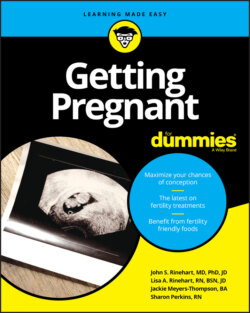Читать книгу Getting Pregnant For Dummies - Sharon Perkins - Страница 37
Abnormalities that can affect fertility
ОглавлениеAround 2 to 3 percent of women have a uterus that is abnormal in its size, shape, or structure. The uterus starts as two separate tubes, which should then join. Once joined, the wall separating the two tubes is dissolved. Sometimes errors in the shape of the uterus occur because there was a failed joining of the tubes (fusion defects) or because the wall does not dissolve (canalization defects). It’s hard to know how many women have uterine anomalies because most women do not have tests to determine the shape of their uterus, so the occurrence will be different for women without infertility and infertile patients who undergo testing. The most common uterine anomaly is the arcuate uterus, which is a very mild fusion problem. The very last part of the tubes fails to join, leaving a somewhat heart-shaped uterus. This type of uterine anomaly does not impact fertility or miscarriage, but it is reported whenever imaging of the uterus (usually using ultrasound) is done — which can cause concern if no one tells you that this is not an important finding. It’s like distinguishing brown eyes from blue eyes; interesting but not predictive of infertility.
The most common variation in the shape of the uterus that can impact fertility and miscarriage rate is caused by a canalization defect and called a septate uterus, which means that a band of tissue (septum) partially or completely divides the inside of the uterus. This is a congenital condition that occurs while a female fetus is developing in utero when the wall is not properly dissolved. It can affect all or part of the wall so there are many variations on how much of a septum occurs. Septate uterus occurs in multiple forms in less than 3 percent of all women. Fusion defects can create a uterus with two horns (bicornuate) or two separate uteri or even two cervices and two vaginas. Sometimes only one tube forms and thus only one side of the uterus develops, and there is no fallopian tube on that side since the fallopian tubes also develop from the initial tube. This is called a unicornuate (one horn). Depending upon the extent of the abnormality, women who have bicornuate and unicornuate uteri usually do not have problems conceiving or keeping a pregnancy. Fusion defects may result in pregnancy complications such as premature labor or malpresentation of the fetus such as a breech. Treatment for uterine defects depends upon which defect is present, the pregnancy history of the woman, and how severe the defect is. In general, only canalization defects are treated, and these require surgery.
Even if the shape of your uterus is normal, it may contain some unwanted “accessories” — growths such as polyps and fibroids — which may decrease the chance that an embryo can implant and grow in your uterus. These are easily diagnosed by a transvaginal ultrasound and/or an MRI and are not always an issue depending upon where they are located in the uterus. If placement is a problem for an implanting embryo, they can be removed before trying to get pregnant. Polyps are easily removed and don’t cause any complications after they’re gone. Removing fibroids may be more complex. Small ones may be removed through the vagina by entering the uterus through the cervix in an outpatient surgicenter, but large ones may require an abdominal incision and a hospital stay of a couple of days. Removing fibroids can leave scar tissue in the cavity that can make it harder to get pregnant because the fetus won’t be able to implant in the scarred area. In rare cases, you may also need a cesarean section after fibroid removal.
Scar tissue can also form in your uterus after a dilation and curettage (D&C for short) for problems like retained tissue after a delivery or miscarriage. If there’s a lot of scar tissue, nearly filling the uterus, it’s called Asherman’s syndrome. Obviously, the more scar tissue, the harder it becomes to achieve a pregnancy. The scar tissue can be removed surgically, which may increase your chance of achieving a pregnancy. Commonly, the surgery will need to be repeated until enough of the scars have been removed.
